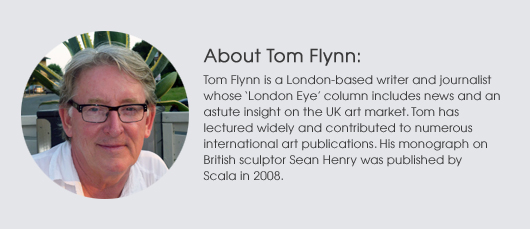LONDON – “I refuse to be exhibited like a prize bull whose chief attraction is his past prowess,” said Sir Winston Churchill in one of his less familiar utterances. His words echoed down through the decades this week as Prime Minister David Cameron and other members of Parliament assembled beneath Oscar Nemon’s bronze statue of Churchill in the lobby of the House of Commons to mark the 50th anniversary of the great man’s state funeral.
Unsurprisingly, the occasion was another opportunity to celebrate Churchill’s “past prowess,” although some commentators chose to draw attention to the war-time leader’s more questionable attitudes toward people of different ethnicities. But if the stature of a politician were to be measured in the number of statues and busts portraying him (or her), few would come close to Churchill whose bulldog gaze stares down from pedestals the world over.
For example, a recent indication of Churchill’s still towering reputation in the United States came in 2013 when a new bronze after the original work by Croation-born British sculptor Oscar Nemon (who made the statue of Churchill in the House of Commons) was unveiled in Statuary Hall, off the Capitol Rotunda. On that occasion, U.S. Secretary of State John Kerry remarked that Churchill would “remain forever an inspiration to those in the Capitol and across the continents.”

Despite having created some of the most memorable portrait statues of the man, Oscar Nemon (1906-1985) remains a somewhat overlooked figure in Churchill lore. Lady Aurelia Young, Oscar Nemon’s daughter and the wife of Sir George Young, a former Leader of the House of Commons in David Cameron’s government, told Auction Central News that, “When Churchill unveiled Nemon’s portrait statue in the Guildhall in 1955, he said: ‘I greatly admire the art of Mr. Oscar Nemon, whose prowess in the ancient realm of sculpture has won such remarkable modern appreciation. I also admire this particular example, which you, my Lord Mayor, have just unveiled, because it seems to be such a very good likeness.’” Churchill, a talented painter in his own right, also tried his hand at sculpture and made a bust of Nemon in tribute to his good friend and portraitist.
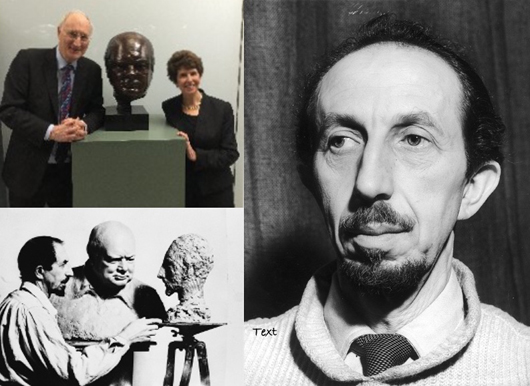
It was surely no coincidence, given the anniversary of the funeral, that a number of other versions of Nemon’s portraits of Churchill have turned up under UK auction hammers recently. In December, Sotheby’s dispersed items from the collection of Lady Mary Soames, Churchill’s youngest daughter. Included in that sale was a small resin bust of Churchill after the work by Nemon.
For some reason, Sotheby’s estimated this at just £300-£400, a risible forecast that was summarily demolished by a hammer price of £35,000. Had Sotheby’s followed the example of Christie’s by levying the notorious “reward fee” for beating their own upper estimate — an innovation recently greeted with uproar from the trade (and from many regional auctioneers to boot) — they would have earned a very nice additional bonus. Happily they have not … at least not yet.
The highest price from the Soames sale was the £1.5 million ($2.26m) that changed hands for The Goldfish Pool at Chartwell, one of Churchill’s own more accomplished watercolors, which had been a little more realistically estimated at £400,000-£600,000.
Meanwhile, on Jan. 27, Bonhams offered an interesting miniature gold bust of Churchill formerly in the collection of the late British-born Hollywood film star Stewart Granger (1913-1993) which realised £7,500 ($11,300).
Interviewed on the BBC’s long-running Desert Island Discs radio program in 1981, Granger was asked, as all guests of the program are, which luxury he would like to take to the island. His first reply “A blonde?” was rejected by presenter Roy Plumley. Granger went on to choose his bust of Churchill. “Churchill was my great hero during the war,” he said. “I thought he was absolutely fantastic. And Nemon did this statue of him which is now in the Houses of Parliament and Aspreys were clever enough to get Nemon to do some miniatures and I think he did 15 in gold and 200 in silver. I had a few bob to spare, so I went into Apreys and I bought one in gold…and wherever I go he goes in the bag with me.”
Some may conclude that taking a gold bust of Churchill on one’s travels constitutes a significant insurance risk. Had Granger been robbed of his treasured objet d’art, to whom would he have turned? Happily today there are a few more options open to those who suffer losses than there were in Stewart Granger’s day. Dealers, museums and private collectors are now obliged to conduct comprehensive “due diligence” checks into whether an object being offered for sale comes with clear provenance and good title. Until recently there were few reliable places to go to conduct such checks but there is now a new kid on the “due diligence” block. Last week saw the launch at the Royal Institution of Art Claim, a database established by the Art Recovery Group, which has brought together innovative technology and what it describes as “an intuitive user interface and integrated image-recognition software” to provide “an unprecedented degree of reliability and range for professional due diligence in the art market and cultural heritage sector.”
The Art Claim database and related services are the brainchild of London-based American lawyer, Christopher Marinello, who identified the need for a more ethical approach to due diligence than anything currently being offered. Marinello and his colleagues welcomed art market consultants, art insurance professionals, art journalists and others to the Royal Institution to mark the launch of the new service.
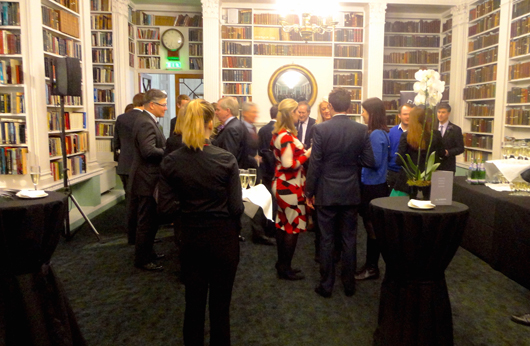
And so to one of the most popular events in the capital’s winter fairs season. The Works on Paper Fair, which again takes place at London’s Science Museum, will feature another mouth-watering display of works from across all periods and in a broad range of media. The highlights this year include a rare etching after Rembrandt (1606-1699) titled The Writing Master. This 18th-century impression, after the original dated circa 1658, is a portrait of one Lieven Willemsz Van Coppenol (circa 1599-1677), who began his career as the headmaster of the French School in Amsterdam, until illness caused his early retirement. Thereafter he pursued his passion for calligraphy, hence the title of the work. It is for sale at an as yet undisclosed price with Elizabeth Harvey-Lee.
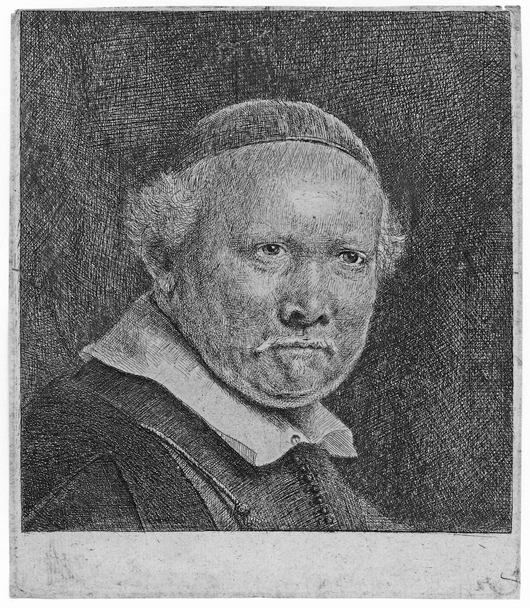
Paul Sandby (1730-1809) is one of the most admired of English 18th-century British watercolorists. As a result, his works are included in some of the most prestigious public and private collections, including that of the late Queen Mother who had a particular penchant for his landscapes. Thus there is likely to be great interest in the fine example to be offered by dealer Charles Nugent at the Works on Paper Fair. Roche Abbey, Yorkshire, in watercolor and bodycolor, is for sale priced at £28,000 ($42,070).
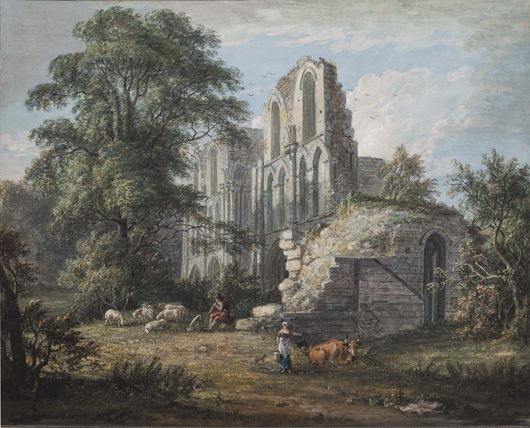
Another item with mentioning is a composition sure to underscore the perennial appeal of the Venetian vedute — William James Muller’s (1812-1845) watercolor The Rialto, Venice. It will be for sale at the fair with dealer James Mackinnon priced at £9,500 ($14,275).
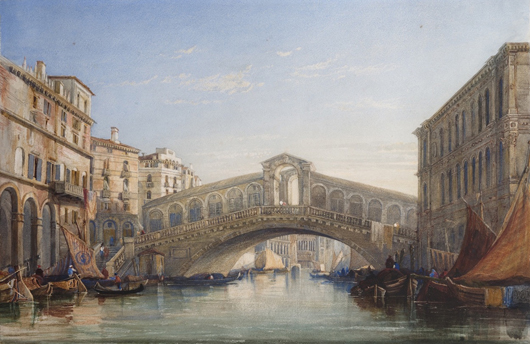
And finally, a note about one of the most potentially exciting finds in the sculpture realm. A pair of very fine large bronzes from a UK private collection have been subject to renewed scrutiny by scientists and art historians led by Paul Joannides, emeritus professor of art history at the University of Cambridge.
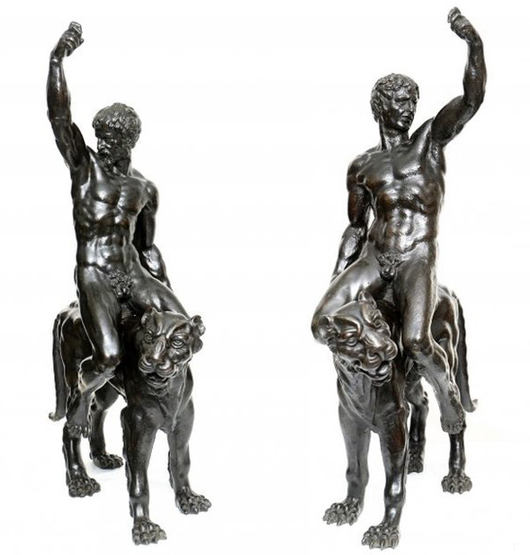
Ever since the 19th century, the figures, depicting male bacchantes riding panthers, have been attributed to the Dutch sculptor Willem Danielsz Van Tetrode (circa 1530-1587). However, Professor Joannides has now uncovered what appears to be compelling documentary evidence that may tie the bronzes to the great High Renaissance master himself. They will be on display at the Fitzwilliam Museum in Cambridge until Aug. 9. Meanwhile, the obvious question on the lips of art market watchers is: Will they eventually be consigned to the auction block? Now a pair of Michelangelo bronzes would make the headlines.
